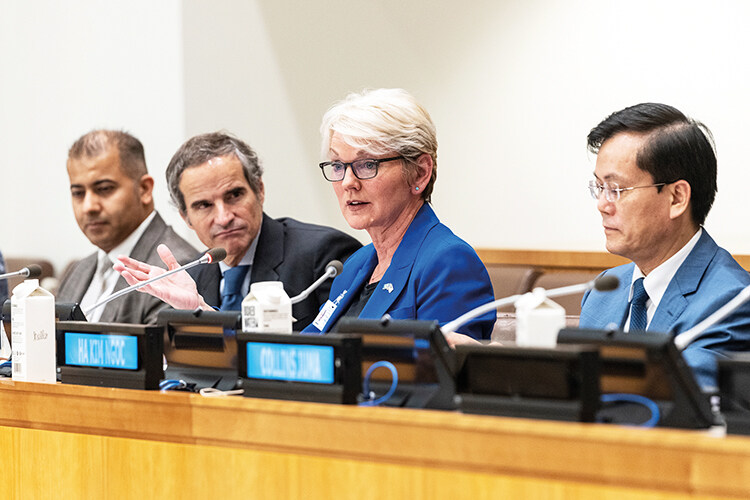


Andrew Brooks on why comparisons between the space race and the global environmental crisis are both misleading and counter-productive
To understand the global challenge of climate change, we often use comparisons as a way of simplifying its complexity, but these can be deeply misleading.
The most obvious is the misnomer ‘the greenhouse effect’. A real greenhouse is designed to preserve heat and have a positive effect on the life developing within. Emissions of carbon dioxide and other ‘greenhouse gases’ are trapping heat, leading to dangerous warming, but not only warming. Some regions are impacted by localised cooling, drought and flooding – heating isn’t the only impact of climate change. Furthermore, the comparison is misleading as a greenhouse can be quickly cooled, by removing panes of glass. There is no such quick fix to remove carbon from the atmosphere; it’s a thickening layer that will continue to grow for 30 years after emissions are cut to zero. The metaphor oversimplifies the immense problem of global climate change.
Recently, politicians and other influential voices have drawn parallels between the climate emergency and the space race. A ‘moonshot’ is often referenced when potential solutions to the environmental crisis are discussed. Famously, US President John F Kennedy said, ‘We choose to go to the moon’ in 1962 and launched a huge industrial effort. Could the achievements of NASA in the 1960s be an inspiration for solving today’s planetary problems? Does it make sense to compare the space race with efforts to tackle climate change?
Making an environmental problem into a space mission is a great way to grab attention. US Energy Secretary Jennifer Granholm has said that fighting climate change is ‘our generation’s moonshot’. Microsoft has launched a ‘moonshot’ to go carbon neutral by 2030. Media outlets from the Financial Times to the New Statesman have called for a ‘moonshot’ to address the climate crises. It’s a word that appears to beckon boldness.
There are two characteristics of the ‘moonshot’ that are invoked when it’s used as a model for the climate crisis. First, the Apollo missions of the 1960s and ’70s had commitment and unity of purpose. Getting to the moon required unprecedented expenditure – US$26 billion between 1960 and 1973, equivalent to more than US$200 billion today. A huge workforce with a wide range of technical and scientific skills was put to the task. Coordination between different areas of government, universities and the private sector was essential. It was also risky and controversial, with many Americans questioning if it was an appropriate use of resources at a time when the nation faced many domestic and international challenges, such as the civil rights movement and the war in Vietnam. Political support from the very top was essential to maintain the project, as were flexibility and ingenuity at every level of the mission. Second, it had a clearly defined goal. Success and failure were very easy to measure. Once Neil Armstrong made it back home safe with his crew, it was mission accomplished.

Starting with the first characteristics, it’s right to say that addressing climate change also requires massive change and action across science, business and government. Yet there’s a fundamental difference of scale. The lunar missions leveraged the resource of one single – albeit very powerful – nation with a then population of 185 million. The climate crisis is a global issue that touches the lives of all eight billion people. The space race happened against the backdrop of the Cold War. Nationalism was a powerful force in unifying America’s efforts – you can’t picture the rockets of NASA and the spacesuits of the astronauts without the stars and stripes. There is no such equivalent cultural glue to hold the population of the world together. We aren’t all invested in the challenge. On the one hand, Extinction Rebellion protesters are willing to face prison when they call for action, while at the same time, climate sceptics are still an influential voice in the global media, and there are millions, if not billions, around the world who are poor and lack the formal education required to understand the emerging crisis or the political influence to demand a response. Visiting the moon involved many complicated parts operating together, including rockets, guidance systems, life support, lunar landers and more. Tackling climate change is an infinitely more complex set of problems.
Turning to the second point of difference, the type of outcome that would resolve each challenge is utterly incomparable. The Apollo missions had a simple goal: get to the moon. Yes, there were some further mission criteria, but the big prize was obvious to everyone, and ever since it was achieved, NASA’s manned space programmes have dwindled in scale. In contrast, what is the goal of the climate science community? Halting global temperature rises at 2°C, 1.5°C or 1°C, or less? Reducing carbon dioxide concentrations in the atmosphere to 300 parts per million (ppm) or allowing 400ppm or 500ppm, or going back to the levels from the pre-Industrial Revolution? Stopping the melting of ice caps and disappearance of glaciers? Capping carbon emissions at a certain level per person? What is the time frame for achieving whatever goal is selected? Many different targets could be set, and the scale of societal change required to deliver some of the more ambitious versus less progressive aims is totally different. Politicians, business leaders and scientists have repeatedly failed to reach consensus. So, the lack of a single agreeable target versus the straightforward ‘We choose to go to the moon’ objective illustrates how it simply doesn’t work as a comparison.
More fundamentally, the mission-goal model of a moonshot is completely at odds with the actions needed to reconcile the relationships between humans and the natural environment. Living sustainably is something that will forever need attention. There can’t be an end point. It needs a permanent reorganisation, not a fixed-term solution such as the Apollo programmes. Into the future, humans will always need to restrict net carbon emissions alongside the release of other harmful gases. Yet global environmental change is not just about releasing less CO2 into the atmosphere but a much broader suite of wider, often interconnected, environmental issues. ‘Fixing’ climate change will not alone repair the damage done to the planet as there is a much more expansive suite of problems – including ocean acidification, species extinction, deforestation and water pollution – that are also life-threatening. We must re-evaluate what type of natural environment we want to sustain.
When searching for an analogy, maybe the Industrial Revolution, the period that spurred the beginning of the climate crises, is a better comparison than the space race. The Industrial Revolution changed the world forever. In the same way that resolving global environmental change will never have a definitive ‘end’, the Industrial Revolution doesn’t really have an agreed ‘start’. From around the 1780s, there were innovations in the use of automated machinery, such as the textile-weaving power looms in northern England, that transformed not only the production of clothes but also society. At the heart of the Industrial Revolution was not just technological innovation but social change. The factories that emerged in the late 18th century radically reorganised work, increased productivity, flooding the market with new consumer goods – biscuits, bricks, pins, rifles and soap – spurred urban growth and transformed the world.
The Industrial Revolution wasn’t just about scientific discoveries, but also new ways of organising work, the economy and society. Maybe an environmental revolution comparable in scope and scale is what is required today, with new green technology, but also new permeant types of social organisation, political ideas and economic systems. In contrast, the model of a moonshot is much less ambitious and seeks to find an engineering solution to a problem that’s as much social as it is technical. We need to rethink our relationship with the natural world and transform attitudes towards pollution, the loss of plant and animal species, and the destruction of natural landscapes, as well as finding innovative technologies to cut emissions to net zero. But there doesn’t appear to be the leadership to will this into action. When political leaders come together and presidents and prime ministers call for action on climate, their speeches fail to catalyse change. When Kennedy launched the moonshot, his words were famous, stirring and powerful. Sadly, when Joe Biden and others speak on the environment, their contributions are forgettable, insipid and empty.




